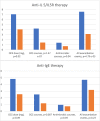A comparison of biologicals in the treatment of adults with severe asthma - real-life experiences
- PMID: 32467765
- PMCID: PMC7222440
- DOI: 10.1186/s40733-020-00055-9
A comparison of biologicals in the treatment of adults with severe asthma - real-life experiences
Erratum in
-
Correction to: A comparison of biologicals in the treatment of adults with severe asthma - real-life experiences.Asthma Res Pract. 2020 Oct 2;6:10. doi: 10.1186/s40733-020-00063-9. eCollection 2020. Asthma Res Pract. 2020. PMID: 33024570 Free PMC article.
Abstract
Background: Anti-IgE (omalizumab) and anti-IL5/IL5R (reslizumab, mepolizumab and benralizumab) treatments are available for severe allergic and eosinophilic asthma. In these patients, studies have shown beneficial effects in oral corticosteroid use and exacerbations. The aim of this retrospective single-center study was to evaluate the effect of biological therapy on severe asthma and to compare different therapies.
Methods: We collected and analysed results of anti-IL5/IL5R and anti-IgE therapies for asthma from January 2009 until October 2019 in specialized care. We compared number of exacerbations, asthma symptoms and use of per oral corticosteroids and antimicrobics because of asthma before and during biological therapy, and in a separate analysis need for per oral corticosteroids, antimicrobics or surgery due to upper respiratory tract diseases in asthmatics receiving biologicals. The analyses were done using the Chi square test, T-test or Mann-Whitney U -test, the Kruskall-Wallis test or the Wilcoxon test.
Results: Of 64 patients, 40 used continuous per oral corticosteroid therapy prior to biological therapy. The mean daily dose of per oral corticosteroid was reduced in those with anti-IL5/IL5R therapy (- 3.0 mg, p = 0.02). The number of annual per oral corticosteroid courses decreased in both the anti-IL5/IL5R (- 2.8 courses, p < 0.05) and anti-IgE groups (- 1.3 courses, p < 0.05). The number of annual antibiotic courses (- 0.7 courses, p = 0.04) and total number of exacerbation events (- 4.4 events/year, p < 0.05) were reduced in the anti-IL5/IL5R group. In the 55 asthma patients analysed for upper respiratory tract findings, the results suggested a reduction in need for chronic rhinosinusitis surgery during biological therapy.
Conclusions: Results with biological therapies in this real-life clinical setting are comparable to those reported in clinical trials. Biological therapy reduces exacerbations and per oral corticosteroid use.
Trial registration: NCT04158050, retrospectively registered 6.11.2019.
Keywords: Anti-IL5; Anti-IgE; Asthma; Biological therapy; Chronic rhinosinusitis; Corticosteroid; Eosinophils; Exacerbation; IgE.
© The Author(s) 2020.
Conflict of interest statement
Competing interestsThe authors declare that they have no competing interests concerning this work. Outside this work, Emma Kotisalmi has received a personal fee from the Finnish doctors’ society Duodecim for a manuscript and an abroad congress fee from Orion Pharma. Outside this work, Paula Kauppi has received personal fees from Novartis, TEVA, and GSK for lecturing, personal fees from Sanofi and The Finnish Work Environment Fund for consultancy and a personal fee from Fimea for a manuscript. Outside this work, Sanna Toppila-Salmi has received personal fees from Mylan Laboratories Ltd., Biomedical systems Ltd., Roche Products Ltd., Sanofi Pharma Ltd. and Novartis Investments for consultancy.
Figures

Similar articles
-
A comparison of the impact of anti-IL5/5r therapies in allergic versus non-allergic patients with severe eosinophilic asthma in a real-life setting.J Asthma. 2025 Feb;62(2):319-327. doi: 10.1080/02770903.2024.2400607. Epub 2024 Sep 14. J Asthma. 2025. PMID: 39235972
-
Anti-IL5/IL5R Treatment in COPD: Should We Target Oral Corticosteroid-Dependent Patients?Int J Chron Obstruct Pulmon Dis. 2023 May 5;18:755-763. doi: 10.2147/COPD.S370165. eCollection 2023. Int J Chron Obstruct Pulmon Dis. 2023. PMID: 37180748 Free PMC article.
-
Impact of Anti-IL5 Therapies on Patients with Severe Uncontrolled Asthma and Possible Predictive Biomarkers of Response: A Real-Life Study.Int J Mol Sci. 2023 Jan 19;24(3):2011. doi: 10.3390/ijms24032011. Int J Mol Sci. 2023. PMID: 36768331 Free PMC article.
-
Efficacy and safety of treatment with biologicals (benralizumab, dupilumab, mepolizumab, omalizumab and reslizumab) for severe eosinophilic asthma. A systematic review for the EAACI Guidelines - recommendations on the use of biologicals in severe asthma.Allergy. 2020 May;75(5):1023-1042. doi: 10.1111/all.14221. Epub 2020 Feb 24. Allergy. 2020. PMID: 32034960
-
Omalizumab as alternative to chronic use of oral corticosteroids in severe asthma.Respir Med. 2019 Apr;150:51-62. doi: 10.1016/j.rmed.2019.02.003. Epub 2019 Feb 7. Respir Med. 2019. PMID: 30961951 Review.
Cited by
-
Correction to: A comparison of biologicals in the treatment of adults with severe asthma - real-life experiences.Asthma Res Pract. 2020 Oct 2;6:10. doi: 10.1186/s40733-020-00063-9. eCollection 2020. Asthma Res Pract. 2020. PMID: 33024570 Free PMC article.
-
Real-world efficacy of treatment with benralizumab, dupilumab, mepolizumab and reslizumab for severe asthma: A systematic review and meta-analysis.Clin Exp Allergy. 2022 May;52(5):616-627. doi: 10.1111/cea.14112. Epub 2022 Mar 9. Clin Exp Allergy. 2022. PMID: 35174566 Free PMC article.
-
Saudi Arabian real-life experience with biologic therapy in severe asthma.Multidiscip Respir Med. 2021 Dec 29;16(1):807. doi: 10.4081/mrm.2021.807. eCollection 2021 Jan 15. Multidiscip Respir Med. 2021. PMID: 35070293 Free PMC article.
-
Complete response to anti-interleukin-5 biologics in a real-life setting: results from the nationwide Danish Severe Asthma Register.ERJ Open Res. 2022 Oct 4;8(4):00238-2022. doi: 10.1183/23120541.00238-2022. eCollection 2022 Oct. ERJ Open Res. 2022. PMID: 36199589 Free PMC article.
-
Impact of type 2 targeting biologics on acute exacerbations of chronic rhinosinusitis.Allergy Asthma Proc. 2021 Sep 1;42(5):417-424. doi: 10.2500/aap.2021.42.210058. Allergy Asthma Proc. 2021. PMID: 34474711 Free PMC article.
References
-
- Global Initiative for asthma . Global Strategy for Asthma Management and Prevention. 2019.
-
- Chung F, Wenzel SE, Brozek JL, Bush A, Castro M, Sterk PJ, et al. Erratum: “International ERS/ATS guidelines on definition, evaluation and treatment of severe asthma”. Eur Respir J. 2018;52(1):13993003. - PubMed
Associated data
LinkOut - more resources
Full Text Sources
Medical

